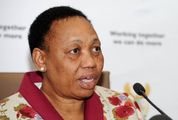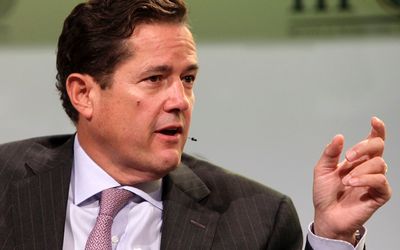LONDON — Barclays Plc fell the most in more than three years in London trading on Tuesday as investors balked at CEO Jes Staley’s pitch that more short-term pain will be necessary for the bank to right itself.
The lender cut its dividend for the next two years and said costs from its noncore division will rise this year as it accelerates the unit’s wind-down, according to a statement Tuesday. The shares plummeted 9.3% to 156p in the afternoon in London, the most since June 2012. The stock has dropped 29% this year, more than any other large UK lender.
Mr Staley is reducing the firm’s stake in its Africa unit and moving more businesses into the noncore unit as he looks to shrink the bank, boost capital ratios, and focus on the UK and US markets.
Mr Staley, who started in December, is keeping the firm’s investment bank, describing calls to exit the business "shortsighted".
"The slightly worrying thing is that management now thinks they need more capital, which indicates there are more fines to come and confidence in earnings might not be as strong," said Alan Beaney, investment director at RC Brown Investment Management, which owns Barclays shares. "We obviously don’t like that they cut their dividend, but I think they’re doing the right thing."
The company cut its dividend to 3p per share for 2016 and 2017, from 6.5p last year.
It also will sell down its 62% stake in Barclays Africa Group over the next two to three years to a level that allows it to deconsolidate the unit. The measures will boost the firm’s common equity Tier 1 ratio by at least 1 percentage point from its 11.4% at the end of 2015.
‘Hard Decisions’
Reducing the dividend took many investors by surprise, and Mr Staley saidthe bank will get back to paying out a "significant" percentage of profits in a dividend in 2018.
"These are hard decisions, but we believe that shareholder value in getting noncore closed will significantly exceed any downside of cutting the dividend for two years,"Mr Staley said in a presentation to analysts on Tuesday. "These strategic actions will bring forward the completion of our restructuring and the emergence of a simpler and very profitable Barclays."
Trading in the stock was temporarily halted as the shares dropped as much as 11%. Analysts at the presentation questioned Staley on his outlook for profit and capital as he maintained that the bank’s future is "bright."
"Look at your stock price, and what it is telling you is, noone is believing your ‘jam tomorrow’ capital story," Chintan Joshi, a bank analyst at Nomura Holdings, told Mr Staley.
Fourth-quarter adjusted pretax profit, including restructuring costs, fell 56% to £247m, according to the filing. That missed the £519m average estimate of fiveanalysts surveyed by Bloomberg. The investment bank swung to its first quarterly loss in at least two years, hurt by a drop in equities revenue, and Finance Director Tushar Morzaria cautioned performance would be worse in the first quarter compared with last year.
‘Shortsighted’ Move
"Investment banking does not currently generate returns above our cost of equity, and there are some who have recommended we would be wise to exit this business entirely," Mr Staley said. "I disagree, and I think that such a move would be very shortsighted. Barclays will ultimately be a stronger group with an investment bank" as it provides a "cyclical counterweight" to the consumer business.
The strategy did not feature any significant additional cuts to the investment bank, disappointing some investors who had viewed that as a way to boost capital in place of cutting the dividend.
"Note to the board: don’t cut the dividend (again) without ample signalling beforehand," wrote Sandy Chen, a bank analyst at Cenkos Securities. "Note to the CEO: don’t defend the investment bank, on the hope that its profitability will beat its cost of capital again. And the argument that investment banking and retail banking cycles would counterbalance each other was met with scepticism — that is not how we remember the sub-prime crisis."
The company added £8bn of risk-weighted assets to its noncore division, bringing the total to £55bn, and said it would speed up divestment of assets in that unit to reach £20bn by 2017. The businesses being transferred to noncore are wealth-management units in Asia and the Americas, units in at least nine countries including Egypt and Zimbabwe, and certain product lines in the investment bank.
New Divisions
Mr Staley also unveiled a new structure for the lender, splitting it into two divisions to comply with UK law requiring the separation of banks’ consumer and investment-banking arms by 2019. The so-called UK ringfenced retail bank will have about £70bn of risk-weighted assets, whereas the non-ringfenced business, called Barclays Corporate and International, is almost three times as large with about £195bn of assets, according to the statement. It will house the investment bank, most of the wealth management unit, and the US and international cards businesses.
The African business had 9.5% of the bank’s risk- weighted assets at the end of 2015.
Barclays has operated in the continent for almost a century and its stake in Johannesburg-based Barclays Africa Group was built up under former CEOs John Varley and Robert Diamond. The UK lender would like to hold a minority stake in the business, Mr Staley said.
The bank also softened its financial guidance.The bank was now aiming for a return that is "attractive" to shareholders and "double-digit" return on tangible equity in both of its core divisions. It previously targeted an 11% return on equity for this year. Return on equity fell to negative 1.6% in the fourth quarter from 1.5% a year earlier.
The bank is now aiming for a cost-income ratio of "below 60", softening the previous "mid-50s" target, and made a new commitment to maintain the group’s CET1 (common equity tier 1) ratio at 100 to 150 basis points more than the minimum level demanded by regulators.
"We would have hoped for more scaling back at the investment bank, but it is pleasing to see the capital build," Paul Dilworth, an investment manager at Kames Capital, an Edinburgh-based fixed-income firm that oversees about £55bn including Barclays bonds. "It’s just all about the delivery now. And that comes down to your view of the management team: I feel quite constructive, but clearly some equity investors don’t."
Bloomberg





















Change: -0.47%
Change: -0.57%
Change: -1.76%
Change: -0.34%
Change: 0.02%
Data supplied by Profile Data
Change: -1.49%
Change: -0.37%
Change: -0.47%
Change: 0.00%
Change: -0.49%
Data supplied by Profile Data
Change: 1.40%
Change: 1.54%
Change: 1.12%
Change: 0.88%
Change: 1.28%
Data supplied by Profile Data
Change: 0.10%
Change: -0.84%
Change: -0.07%
Change: -1.38%
Change: -1.13%
Data supplied by Profile Data